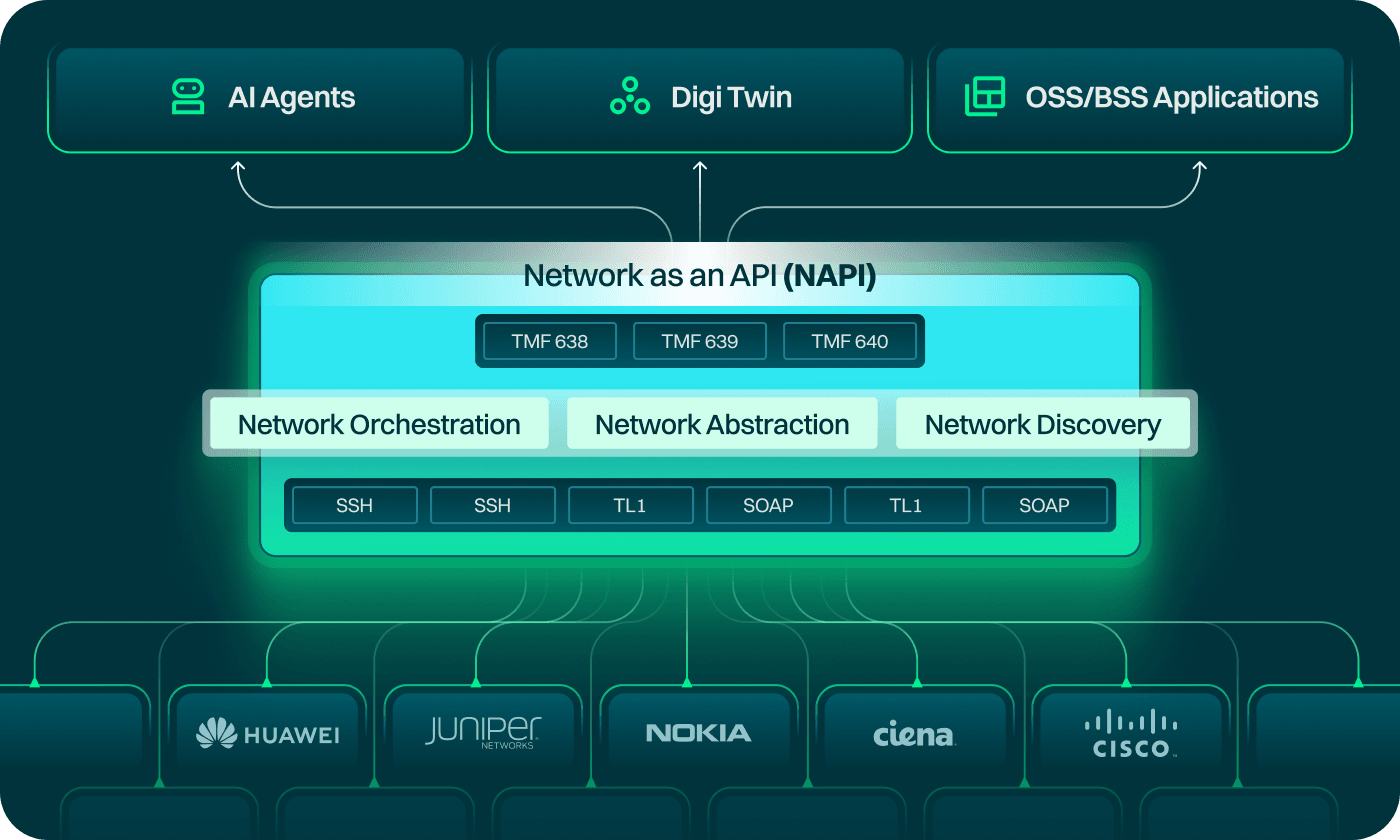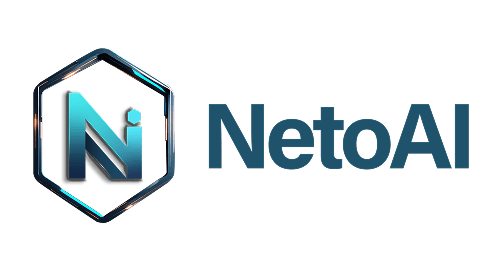Network Orchestration Solution Exposing Network As An API
Simplifies the complexity of configuring and managing both legacy and modern networks through an API

Trusted by visionary
global partners
NAPI Use Cases
NAPI streamlines configuration, orchestration, and service activation across multi-domain, multi-vendor networks by abstracting the network into a standard interface for northbound applications & AI Engine—unlocking automation use cases and accelerating AI-driven transformation
AI Driven Network Configuration
NAPI enables AI-driven configuration by automatically generating device-specific templates and applying validated configurations across multi-vendor networks. With no-code workflows and device-specific syntax-aware intelligence, it ensures consistent, rapid, and error-free configuration without manual intervention.

Intent Driven Orchestration
NAPI enables intent-driven orchestration by translating high-level service intents into executable workflows using service templates, resource templates, and state models supporting multi-domain networks. With seamless integration across platforms and configuration logic, it automates service delivery end-to-end—working hand in hand with DigiTwin’s real-time network insights.

Fully Automated Service Activation
NAPI powers zero-touch service activation by linking service requests to real-time device status, configurations, and dependencies. It ensures services are activated with full validation, reducing order fallout and activation latency.

AI-Powered Network Discovery
NAPI connects to network elements across protocols (SSH, SNMP, REST, NETCONF, TL1, SOAP) using an AI-driven intelligent engine to detect device types, capabilities, and configurations. Its editable templates let you add new attributes to track for flexible management. It collects and normalizes real-time topology, interface, and telemetry data into a vendor-agnostic model.

Intelligent Network Abstraction
NAPI abstracts complex, vendor-specific network information into a unified model, making it easy to manage across domains. It exposes a consistent interface aligned with TMF638, TMF639, and TMF640 APIs for Northbound applications. This enables AI agents, OSS/BSS, and external systems to interact seamlessly with the network resulting in faster integration, reduced complexity, and scalable automation.


AI Driven Network Configuration
NAPI enables AI-driven configuration by automatically generating device-specific templates and applying validated configurations across multi-vendor networks. With no-code workflows and device-specific syntax-aware intelligence, it ensures consistent, rapid, and error-free configuration without manual intervention.

Intent Driven Orchestration
NAPI enables intent-driven orchestration by translating high-level service intents into executable workflows using service templates, resource templates, and state models supporting multi-domain networks. With seamless integration across platforms and configuration logic, it automates service delivery end-to-end—working hand in hand with DigiTwin’s real-time network insights.

Fully Automated Service Activation
NAPI powers zero-touch service activation by linking service requests to real-time device status, configurations, and dependencies. It ensures services are activated with full validation, reducing order fallout and activation latency.

AI-Powered Network Discovery
NAPI connects to network elements across protocols (SSH, SNMP, REST, NETCONF, TL1, SOAP) using an AI-driven intelligent engine to detect device types, capabilities, and configurations. Its editable templates let you add new attributes to track for flexible management. It collects and normalizes real-time topology, interface, and telemetry data into a vendor-agnostic model.

Intelligent Network Abstraction
NAPI abstracts complex, vendor-specific network information into a unified model, making it easy to manage across domains. It exposes a consistent interface aligned with TMF638, TMF639, and TMF640 APIs for Northbound applications. This enables AI agents, OSS/BSS, and external systems to interact seamlessly with the network resulting in faster integration, reduced complexity, and scalable automation.
Core Capabilities of NAPI
TMForum compliant Network APIs
NAPI exposes the network through standards-based APIs—compliant with TMF638, TMF639, and TMF640—enabling seamless integration across OSS/BSS and AI systems, while unlocking smarter monetization of the network as an API
No-Code/Low-Code Platform
NAPI allows users to configure and manage services by simply entering required inputs via a guided UI—no scripting or coding needed.
Universal Network Compatibility
Built-in support for 100+ device types and seamless operation across devices, vendors, domains, and protocols (SSH, TL1, SOAP, SNMP, REST, NETCONF) through AI-generated, template-driven integration.
Domain-Agnostic Architecture
NAPI supports multi-domain environments—including transport, core, and access networks—across both wired and wireless infrastructures, enabling unified management and orchestration regardless of technology or vendor.
NAPI Workflow
NAPI’s AI-powered workflow connects, discovers, and activates devices through a seamless API-driven process—ensuring real-time control across the network lifecycle.
Step 1
AI-Driven Configuration
Automatically generates device-specific syntax from AI-enhanced templates, validates against policies, and applies configurations at scale. Pre-checks ensure accuracy, compliance, and zero service disruption.
Step 2
Intelligent Device Onboarding
Securely discovers and authenticates devices, assigns them to domains, and updates inventory. Live topology maps and real-time telemetry provide instant visibility into connectivity and performance.
Step 3
Automated Testing & Diagnostics
Executes automated pre- and post-deployment tests for reachability, QoS, and routing integrity. AI-driven diagnostics detect anomalies, pinpoint root causes, and recommend one-click remediation.
Step 4
Unified Intent-to-Activation Workflow
Transforms service intent into coordinated workflows that unify configuration, orchestration, and activation. Integrates seamlessly with OSS/BSS, controllers, and inventory for closed-loop automation.
Step 5
Real-Time Network State Dashboard
The centralized dashboard displays the real-time lifecycle state of all devices and services, with built-in KPI tracking, vendor-specific performance comparisons, and QoS indicators—enabling smarter device and service management across domains.
Other Industrial Use cases

Intelligent Fallout Management
A Tier-1 operator used NAPI to detect and resolve 2849 annual service alerts (1187 hours) in real time by validating network readiness and auto-correcting mismatches before activation—eliminating over 90% of failures. This drastically reduced manual intervention and significantly improved provisioning reliability

AI-Driven Device Migration
Powered by NAPI, the Network Migration Agent orchestrates large-scale TDM-to-IP transformations with precision and speed. In one deployment, over 800 sites were migrated seamlessly, leveraging real-time network state modeling and intelligent automation. AI-trained agents autonomously execute pre-migration validation, post-migration checks, and service availability testing—ensuring zero-touch execution and minimal disruption.

AI-Powered Network Discovery
A leading US-based CSP used NAPI to automatically discover and map over 100,000 network devices across multi-vendor, multi-domain environments. By connecting via standard protocols (SSH, SNMP, REST, NETCONF, TL1, SOAP) and using AI-driven detection, NAPI identified device types, interfaces, and configurations—normalizing all data into a unified, real-time model to keep the entire network inventory continuously up to date.
Top Resources for You
NAPI enabled us with full network visibility in hours, not weeks — uncovering blind spots and simplifying management across legacy and modern devices
